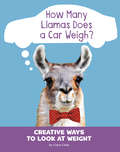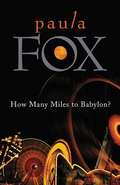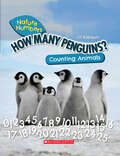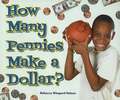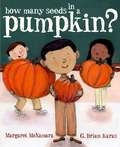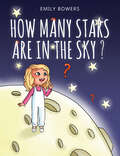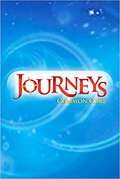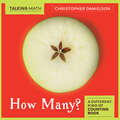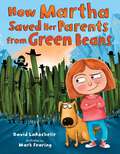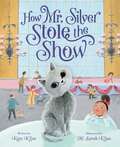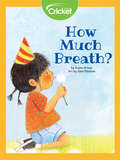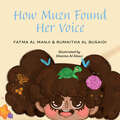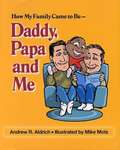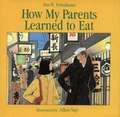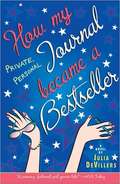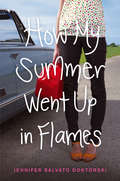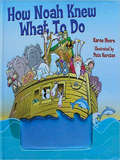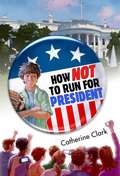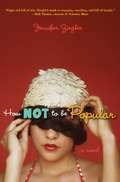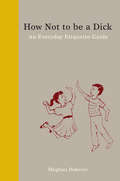- Table View
- List View
How Many Llamas Does a Car Weigh?: Creative Ways to Look at Weight (Silly Measurements)
by Clara CellaLlamas, hot dogs, and six other silly, non-standard measuring units demonstrate the math concept of weight. Pre-readers learn the weight of a car, a hummingbird, a burger, and more through the use of surprising composite photos and a bit of text.
How Many Miles to Babylon?
by Paula FoxTen-year-old James skips school to go to his secret place, a deserted house, where he is found by three teenage boys who force him to join their dognapping ring.
How Many Penguins?: Counting Animals 0-100 (Nature Numbers)
by Jill EsbaumIn Nature Numbers, math is beautiful, recognizable, and all around us! Highly engaging pictures of animals and nature scenes, along with cool chalk illustrations, are used to introduce basic math concepts and encourage kids to see a world of numbers all around them.K-2 math concepts include counting 1-100. This book encourages kids to count groups of 10 animals with amazing nature pictures and chalk illustrations!
How Many Pennies Make A Dollar?
by Rebecca Wingard-NelsonHow many pennies are in a dollar? How many nickels make a dime? In this great book of money combinations, young readers can learn how all of the different denominations of money relate to each other. Free worksheets along with full-color photos and easy-to-read text make this a great way to reinforce math concepts.
How Many Planets Circle the Sun?: And Other Questions About Our Solar System (Good Question!)
by M. CarsonWhy is there life on earth? How did Saturn get its rings? Which planet is biggest, which ones hottest—and which has a cloud named Scooter? Take a trip into outer space to learn about the asteroid belt, Martian volcanoes, dwarf planets, and other fascinating facts about our universe.
How Many Seeds in a Pumpkin?
by Margaret Mcnamara"How many seeds in a pumpkin?" Mr. Tiffin asks his class as they gather around the big, medium, and small pumpkins on his desk. Robert, the biggest kid, guesses that the largest one has a million seeds; Elinor, sounding like she knows what she's talking about, guesses the medium one has 500 seeds; and Anna, who likes even numbers better than odd ones, guesses that the little one has 22. Charlie, the smallest boy in the class, doesn't have a guess. Counting pumpkin seeds is messy business, but once the slimy job is done, to everyone's surprise, the smallest pumpkin has the most seeds! As Charlie happily exclaims, "Small things have a lot going on inside of them."
How Many Stars Are in the Sky?
by Emily BowersLittle Lucy Brown’s curiosity leads her to a mysterious box hidden in her drawer. What secrets does it hold? Join Lucy on an enchanting adventure to uncover the mystery! As Lucy embarks on a journey to the moon, she seeks answers to her burning questions. Along the way, she befriends a delightful creature from the stars, discovering that the journey itself is just as important as the destination. Together, they explore, laugh, and learn, making every moment a memorable part of their celestial adventure. This heartwarming tale celebrates creativity, imaginative thinking, and the joy of discovery. It's a feel-good space story that will delight readers of all ages!
How Many Stars in the Sky? (Journeys)
by Lenny Hort James E. RansomeNIMAC-sourced textbook <P><P>Lexile Measure: AD500L
How Many? (Talking Math Ser.)
by Christopher DanielsonTalking math with your child is fun and easy with this better approach to counting!Written by a math educator, this innovative book encourages critical thinking and sparks memorable mathematical conversations. You and your child decide what to count on each page. You have many choices, and the longer you look, the more possibilities you'll notice. There are no wrong answers in this book. As long as you're talking about what you see, think, and wonder, you're talking math!
How Martha Saved Her Parents from Green Beans
by David LaRochelleMartha HATES green beans. When some mean, green bandits stroll into town, anyone who ever said "Eat your green beans" is in big trouble. But when the beans kidnap Martha's parents, Martha is forced to take action. She can think of only one way to stop the villainous veggies from taking over her town, and it&’s not pretty...or tasty. Featuring absurdly funny text and illustrations with attitude, this is a hilarious read for everyone – even the pickiest of eaters.
How Mountains Are Made
by Kathleen Weidner Zoehfeld James Graham HaleEven though Mount Everest measures 29,028 feet high, it may be growing about two inches a year. A mountain might be thousands of feet high, but it can still grow taller or shorter each year. Mountains are created when the huge plates that make up the earth's outer shell very slowly pull and push against one another. Read and find out about all the different kinds of mountains.
How Mountains Are Made (Let's-Read-and-Find-Out Science 2)
by Kathleen Weidner ZoehfeldRead and find out about how mountains are made in this colorfully illustrated nonfiction picture book.A mountain might be thousands of feet high, but it can still grow taller or shorter each year. This classic picture book explores how mountains are made—including how Mount Everest grew from a flat plain under an ocean to become 29,028 feet tall.How Mountains Are Made features simple activities and fascinating cross-sections of the earth’s moving crust that clearly explain plate tectonics. Both text and artwork were vetted for accuracy by an expert in the field.This is a clear and appealing science book for early elementary age kids, both at home and in the classroom. It's a Level 2 Let's-Read-and-Find-Out, which means the book explores more challenging concepts for children in the primary grades. The 100+ titles in this leading nonfiction series are:hands-on and visualacclaimed and trustedgreat for classroomsTop 10 reasons to love LRFOs:Entertain and educate at the same timeHave appealing, child-centered topicsDevelopmentally appropriate for emerging readersFocused; answering questions instead of using survey approachEmploy engaging picture book quality illustrationsUse simple charts and graphics to improve visual literacy skillsFeature hands-on activities to engage young scientistsMeet national science education standardsWritten/illustrated by award-winning authors/illustrators & vetted by an expert in the fieldOver 130 titles in print, meeting a wide range of kids' scientific interestsBooks in this series support the Common Core Learning Standards, Next Generation Science Standards, and the Science, Technology, Engineering, and Math (STEM) standards. Let's-Read-and-Find-Out is the winner of the American Association for the Advancement of Science/Subaru Science Books & Films Prize for Outstanding Science Series.
How Mr. Silver Stole the Show
by Kate KliseEveryone loves an underdog—especially when he’s a cat! On a rainy morning in 1947, a small gray kitten wandered into the Hamilton Hotel in St. Louis, Missouri, two days before the Greater St. Louis Cat Club Show.A stray kitten. A fancy hotel. A serious contest for pedigreed cats. What could possibly go right?Curl up with this heartwarming story based on a real-life stray cat who made international headlines just by showing up, being himself, and finding a little kindness. . .
How Much Breath?
by Susan GrinerHow much breath does it take to blow the petals off a dandelions, to blow bubbles, and to blow out birthday candles?
How Much Is A Million?
by David M. SchwartzAn attempt to help children conceptualize the immensity of numbers is aided immeasurably by the artist's jovial, detailed, whimsical illustrations.
How Muzn Found Her Voice
by Fatma Al-ManjiThe story’s main character, Muzn, is a young girl living near the Strait of Hormuz and has a fear of public speaking because of her stutter. All Muzn wants is to hide and not speak, but her grandmother and butterfly sidekick Sama never allow her to give up and in fact take her on a journey that changes her perspective forever.
How My Family Came to Be--Daddy, Papa and Me
by Andrew AldrichAlthough this book may normalize a family constellation for some children, it is bound to raise heated discussions of conflict amongst some adults over issues of: cross-racial adoption, gay men adopting a boy, or even gay people adopting children at all.
How My Family Lives In America
by Susan KuklinIn How My Family Lives in America, author-photographer Susan Kuklin zeroes in on the source of cultural identity: the family. <p><p> Meet: <p> Sanu, who is learning how to braid her hair and to cook the same African meal her father makes. <p> Eric, who loves to play baseball with his dad and to dance the merengue with his friends and family. <p> April, who works hard on her Chinese writing and tries to keep up with her family's challenging games. <p> Their stories emphasize the seemingly minor and everyday ways heritage is transmitted: stories, songs, games, language, special occasions. They show the importance of choice and adaptation in forging a cultural identity. And they provoke readers to examine their own families -- what makes them the same, what makes them distinct, and how this uniqueness is celebrated.
How My Parents Learned to Eat
by Ina R. FriedmanAn American sailor courts a Japanese girl and each tries, in secret, to learn the other's way of eating.
How My Private, Personal Journal Became a Bestseller
by Julia DevillersFormerly ordinary 14-year-old Jamie Bartlett is suddenly doing interviews and book signings, flying to L.A. to hang out with celebrities, and dating the hottest guy in school. Will all the attention go to her head?
How My Summer Went Up in Flames
by Jennifer Salvato DoktorskiFirst she lost her heart. Then she lost her mind. And now she's on a road trip to win back her ex. This debut novel's packed with drama and romance!Rosie's always been impulsive. She didn't intend to set her cheating ex-boyfriend's car on fire. And she never thought her attempts to make amends could be considered stalking. So when she's served with a temporary restraining order on the first day of summer vacation, she's heartbroken--and furious. To put distance between Rosie and her ex, Rosie's parents send her on a cross-country road trip with responsible, reliable neighbor Matty and his two friends. Forget freedom of the road, Rosie wants to hitchhike home and win back her ex. But her determination starts to dwindle with each passing mile. Because Rosie's spark of anger? It may have just ignited a romance with someone new...
How Noah Knew What to Do
by Karen Ann MooreChildren are often afraid to try something new. This story will show them how they can trust God to help them do what they need to do--just like He did Noah. How Noah Knew What to Do shows how, even though Noah wasn't a veterinarian or even a ship builder, he listened to God and trusted Him to help him build the ark and fill it with animals. Karen Ann Moore's delightful rhyming text along with Pete Kersten's whimsical illustrations make this a fun way for children to learn they can rely on God in every situation, even when they're doing something they've never done before. Kids will see that obeying God can mean saying "yes" even when the obstacles seem hard to overcome. A gel-pack water-waves novelty that's built into the front cover makes for lots of giggles.
How Not To Run For President
by Catherine Clark"Humorous dialogue, smart pacing and some dirty politics make for an engaging read. With an election around the corner, this isn’t a bad way for young readers to view the political arena. "-Kirkus Reviews When the middle school band is called to play for a presidential campaign rally, Aidan is right there with his clarinet, just in time to save the candidate’s life. Interviewed by the media, he speaks up in favor of the need to save jobs-like his mom’s, for instance. Even though he’s in the middle of Little League season, for pete’s sake, the candidate convinces him to join her tour of the midwest. Problem 1: The candidate’s daughter HATES Aidan. Problem 2: What do you do when your whole life has been turned upside down and you can’t get away from the media? Problem 3: What’s a red-blooded American boy to do when he’s asked to play the clarinet on national TV and the local bully back home is giving interviews saying Aidan’s the nerd of the century?
How Not to Be Popular
by Jennifer ZieglerMaggie Dempsey is tired of moving all over the country. Her parents are second-generation hippies who uproot her every year or so to move to a new city. When Maggie was younger, she thought it was fun and adventurous. Now that she’s a teenager, she hates it. When she moved after her freshman year, she left behind good friends, a great school, and a real feeling of belonging. When she moved her sophomore year, she left behind a boyfriend, too. Now that they’ve moved to Austin, she knows better. She...
How Not to Be a Dick
by Meghan DohertyOn the one hand, nobody wants to be a dick. On the other hand, dicks are everywhere! They cut in line, talk behind our backs, recline into our seats, and even have the power to morph into trolls online. Their powers are impressive, but with a little foresight and thoughtfulness, we can take a stand against dickishness today. How Not to Be a Dick is packed with honest and straightforward advice, but it also includes playful illustrations showing two well-meaning (but not always well behaved) young people as they confront moments of potential dickishness in their everyday lives. Sometimes they falter, sometimes they triumph, but they always seek to find a better way. And with their help, you can too.
